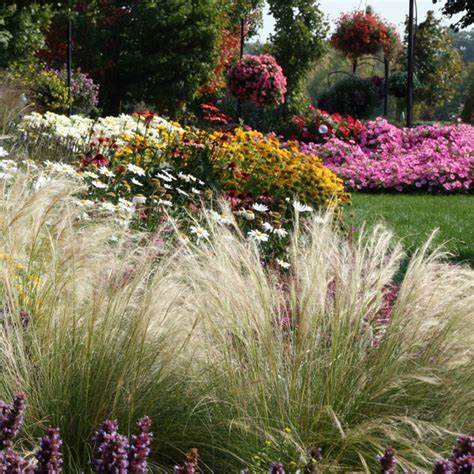
SPOTLIGHT ON ORNAMENTAL GRASSES
by Kathy Torres
The more you experiment in landscaping, the more likely you are to realize that you don’t want every shrub in the yard to be green. In addition to variations in color, a pleasing design will include different plant sizes, leaf shapes and textures. Ornamental grasses provide a breezy, moving plant form that contrasts with existing shrubs and flowers, often producing striking plumes that add to the show. Planted as a focal point, a backdrop for other plant specimens, a border, or even around a pool to create a “pond-in-a-meadow” or a “coastal” feeling, ornamental grasses provide great versatility. Great for erosion control, grasses can be a problem-solver as well. Add to that… low-maintenance, drought tolerance, resistance to disease, and what’s not to love? In fact, many varieties of ornamental grasses are not enticing to deer, a much sought after plant characteristic in our neck of the woods.
Many different size options are available from Pampas grass, with its wide blades and fluffy, white plumes, reaching up to 10 ft. tall and wide, to Blue Fescue grass, with its spiky, silvery blue foliage, one of the smallest varieties growing 1-2 ft. tall and wide. More to come on other types/varieties described below. Cultivars may be annual, perennial, or evergreen and are easily adaptable to most soil types. For best results, plant in full sun, however, many varieties can handle part shade with a minimum of 6 hours of direct sun.
Care requirements will vary depending on the grass type you have. Annual grasses are good for one season and will not survive freezing temperatures. Some perennial grasses will turn brown in winter and can be cut back before new spring growth begins to appear. Other perennial grasses may not turn totally brown, but may show slight winter damage, and a cut back is likely necessary for them as well. Evergreen grasses are fairly maintenance free, but it’s a good idea to trim every couple of years to keep them in shape. Most ornamental grasses can be divided, and this will encourage good plant health.
In the scientific, botanical world, there are plants considered and named as actual “grasses” and then there are “grass-like” plants. Because they are all popular and work well in the landscape, (and all look like grasses), we include them in the family of ornamental grasses, the garden center family, that is, not the botanical family. Anyway, here are some of our favorite grasses:
MAIDEN GRASS, Miscanthus sinensis, is perennial and has a graceful, vase-like shape that displays a soft, airy texture. When it blooms, the foliage is topped by silvery seed heads. There are dwarf and large varieties available for any size garden.
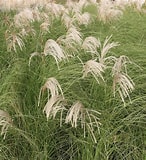
Adagio, 3-5 ft. tall x 3-4 ft. wide
Gracillimus, 4-7 ft. tall x 3-6 ft. wide
Zebrinius, 5-8 ft. tall x 4-6 ft. with variegated leaf blades
MUHLY GRASS, Muhlenbergia capillaris, reaches 2-3 ft. tall x 1-3 ft. wide. This perennial grass is best planted in the spring or fall, a month or so before frost is expected. The long, slender shoots of grass are green and as fall approaches, soft, pink “cotton candy” type flowers appear. Plant in groups or as a border for the full impact of the fuzzy mass of pink or white.
 |
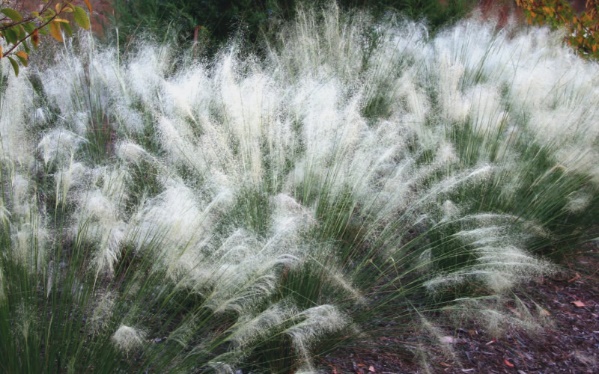 |
LOMANDRA longifolia, AKA Mat Rush, originating from Australia, is an evergreen ornamental grass with medium green, thick, strap-like leaves, accented by spiny flower spikes with tiny creamy yellow male flowers. Plant in full sun to moderate shade. Lomandra is winter hardy to 15-20 degrees. This is a drought tolerant plant once established, particularly when grown in some shade along the coast, but can also tolerate regular irrigation or even wet soils.
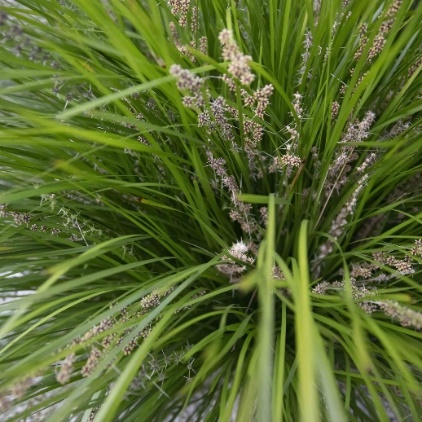
Breeze, 2-3 ft. tall x 3-4 ft. wide
Katrinus, 2-3 ft. tall x 3-4 ft. wide with wider leaf blades
Platinum Beauty, 2-3 ft. tall x 2-3 ft. wide with variegated leaf blades
PENNISETUM GRASS, AKA Fountain Grass, includes many ornamental grasses, both annual and perennial, ranging in size from 1-4 ft. in height. Known for soft, fuzzy flower plumes, they add interest and airy texture to the garden, or make a perfect “thriller” in a container garden on the patio or deck. Foliage color varies from green to burgundy or purple, and include variegated colors. The flowers are perfect for cut and dried flower arrangements.
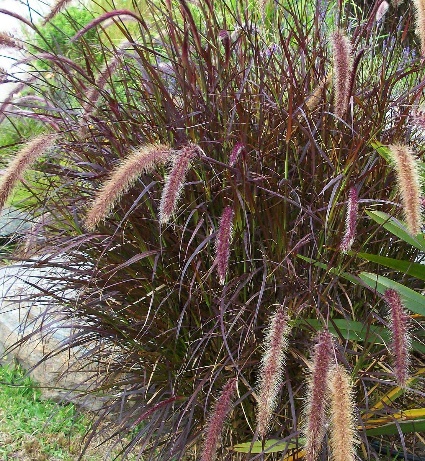 Rubrum (Annual) 4’hx 4’w Hameln |
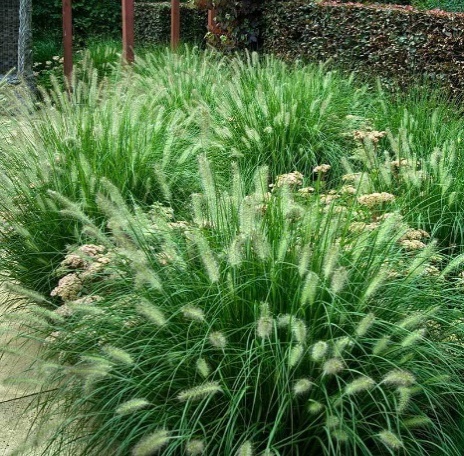 (Perennial) 3’h x 3’w KarleyRose |
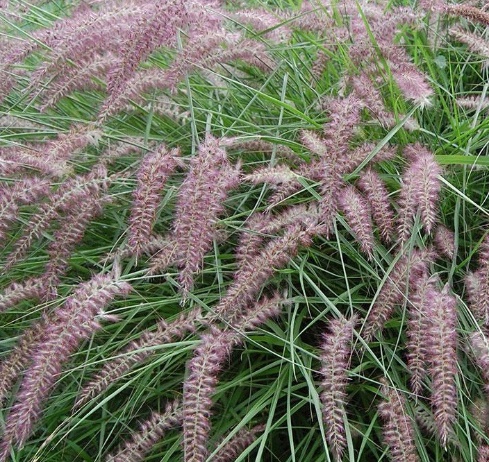 (Perennial) 3’h x 3’w |
SWITCHGRASS, Panicum virgatum, AKA Prairie Grass is a tough perennial grass that has dominated the tall-grass prairies of North America. Upright and sturdy, this narrow ornamental grass serves well as a backdrop to lower growing shrubs or flowers in the landscape. Green stalks/blades may have hints of blue, burgundy or red. In winter, dried flower heads provide interest. Height varies from 3-8 ft. with a typical width of 2-3ft.
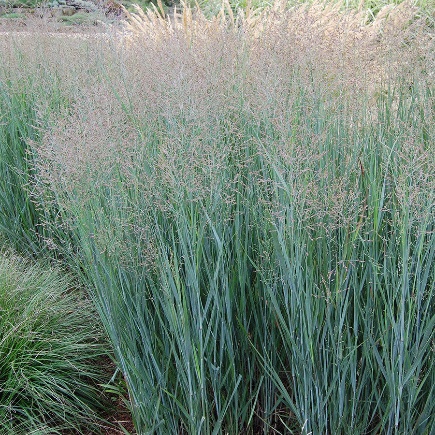 Heavy Metal 5’h x 2’w |
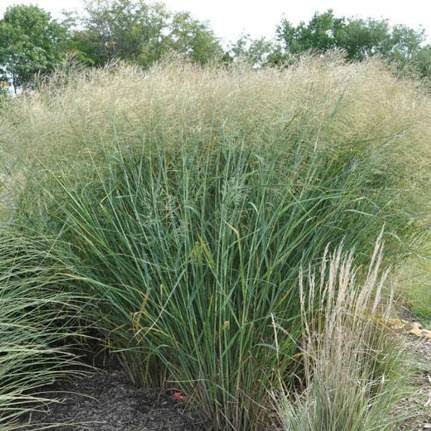 Cloud Nine 8’h x 3’w |
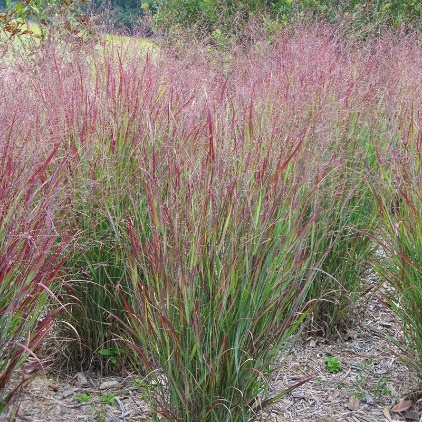 Shenandoah 4’h x 2’w |
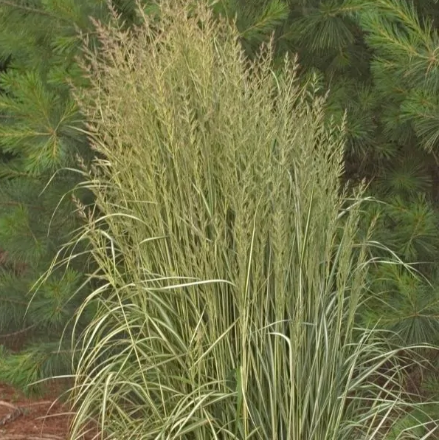 FEATHER REED GRASS, Calamagrostis x acutiflora, similar to Switchgrass, provides showy color and impressive height (3-5 ft. tall and 18-24 inches wide), emerging in spring with a reddish hue. Leaf blades become variegated as they mature and airy, pinkish-purple plumes appearing later in the warm season. Plant this perennial grass individually, in groups or rows, in full or part sun (minimum of 6 hours).
FEATHER REED GRASS, Calamagrostis x acutiflora, similar to Switchgrass, provides showy color and impressive height (3-5 ft. tall and 18-24 inches wide), emerging in spring with a reddish hue. Leaf blades become variegated as they mature and airy, pinkish-purple plumes appearing later in the warm season. Plant this perennial grass individually, in groups or rows, in full or part sun (minimum of 6 hours).
Avalanche
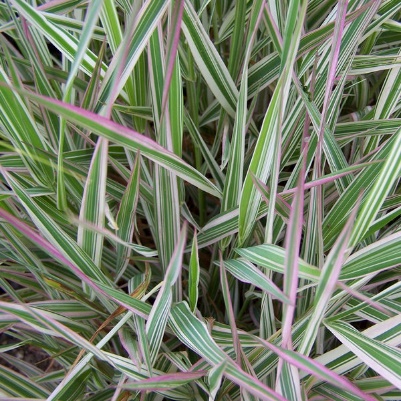 RIBBON GRASS, Phalaris arundinacea, has an upright, arching growth habit, with white-striped foliage blushed with pink. In early summer, panicles of soft white flowers appear. This aggressive grower can handle wet feet, making it great for a pond border. Try it in a large container garden mixed with colorful annuals or perennials. Cut this perennial grass back in winter for fresh, new foliage in spring. Plant in full sun or part shade (minimum of 6 hours).
RIBBON GRASS, Phalaris arundinacea, has an upright, arching growth habit, with white-striped foliage blushed with pink. In early summer, panicles of soft white flowers appear. This aggressive grower can handle wet feet, making it great for a pond border. Try it in a large container garden mixed with colorful annuals or perennials. Cut this perennial grass back in winter for fresh, new foliage in spring. Plant in full sun or part shade (minimum of 6 hours).
Strawberries and Cream, 3 ft. tall x 3 ft. wide
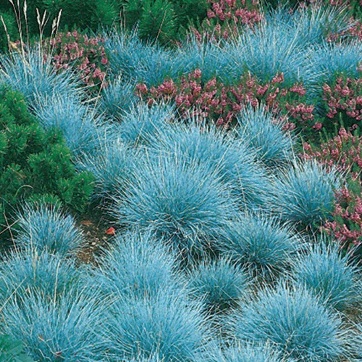 BLUE FESCUE, Festuca glauca, an evergreen grass native to southern France, has a distinct silver-blue color with upright plumes appearing in late summer. It can handle the cold temperatures of winter, as well as the hot, humid summer in South Carolina. Small and compact (8-12 inches tall and wide at maturity), Blue Fescue is perfect as an accent, in mass plantings, containers, and because it is drought tolerant, even in crevices of rock gardens. Dividing every 2-4 years will keep it healthy and growing strong.
BLUE FESCUE, Festuca glauca, an evergreen grass native to southern France, has a distinct silver-blue color with upright plumes appearing in late summer. It can handle the cold temperatures of winter, as well as the hot, humid summer in South Carolina. Small and compact (8-12 inches tall and wide at maturity), Blue Fescue is perfect as an accent, in mass plantings, containers, and because it is drought tolerant, even in crevices of rock gardens. Dividing every 2-4 years will keep it healthy and growing strong.
Elijah Blue is a common variety.
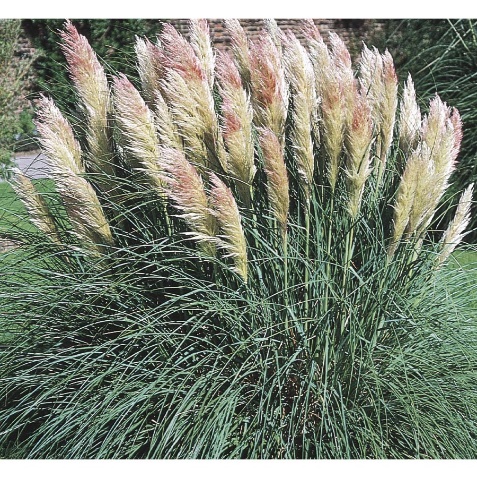 PAMPAS GRASS, Cortaderia selloana, is the “Big Daddy” of perennial ornamental grasses, growing up to 10 feet tall, with dramatic plumes in white or pink. It should be planted in full sun in an area big enough to handle its mature size. Water it well when first planted, but you can pretty much ignore it once established. Divide it occasionally to keep it under control. Pampas grass is great in coastal or lake front areas and for providing privacy screening, or camouflaging HVAC units or undesirable views. Because it is highly flammable, don’t plant it near a grill or fire pit. The leaves or blades of Pampas grass are razor-sharp, so be sure to wear eye protection, gloves and long sleeves when pruning.
PAMPAS GRASS, Cortaderia selloana, is the “Big Daddy” of perennial ornamental grasses, growing up to 10 feet tall, with dramatic plumes in white or pink. It should be planted in full sun in an area big enough to handle its mature size. Water it well when first planted, but you can pretty much ignore it once established. Divide it occasionally to keep it under control. Pampas grass is great in coastal or lake front areas and for providing privacy screening, or camouflaging HVAC units or undesirable views. Because it is highly flammable, don’t plant it near a grill or fire pit. The leaves or blades of Pampas grass are razor-sharp, so be sure to wear eye protection, gloves and long sleeves when pruning.
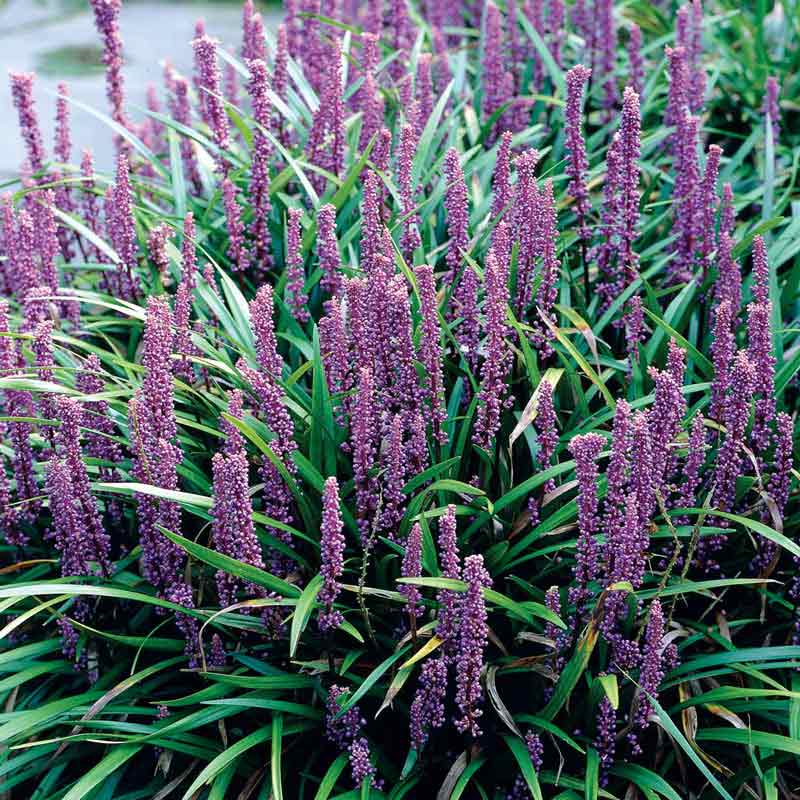
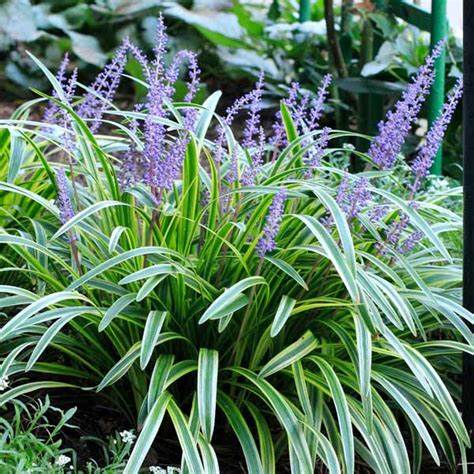 LIRIOPE, AKA Lilyturf or Monkey Grass, is a fast-growing groundcover or border plant. The two most prominent species found here are Liriope muscari and Liriope spicata. Muscari is more clumping and spicata is a spreader. Most Liriope grows to a height of 10-18 inches and a width of 12-18 inches. Typically, the color is dark green, however, there are variegated cultivars available as well. Blooms (usually purple) appear on stalks in summer followed by bluish-black berries in the fall. Extremely tough, Liriope will grow in deep sun or shade. It’s evergreen, however, a good cut back in winter will encourage fresh growth in spring.
LIRIOPE, AKA Lilyturf or Monkey Grass, is a fast-growing groundcover or border plant. The two most prominent species found here are Liriope muscari and Liriope spicata. Muscari is more clumping and spicata is a spreader. Most Liriope grows to a height of 10-18 inches and a width of 12-18 inches. Typically, the color is dark green, however, there are variegated cultivars available as well. Blooms (usually purple) appear on stalks in summer followed by bluish-black berries in the fall. Extremely tough, Liriope will grow in deep sun or shade. It’s evergreen, however, a good cut back in winter will encourage fresh growth in spring.
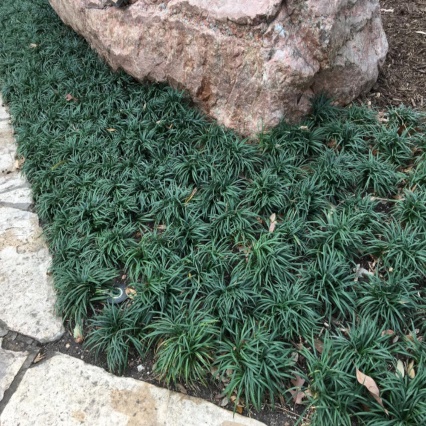 MONDO GRASS, Ophiopogon japonicus, is another evergreen, sod-forming perennial very similar to Liriope that prefers shade, also available in a dwarf size that reaches only 4 inches. It’s a great groundcover under a tree or other area where most lawn grasses fail.
MONDO GRASS, Ophiopogon japonicus, is another evergreen, sod-forming perennial very similar to Liriope that prefers shade, also available in a dwarf size that reaches only 4 inches. It’s a great groundcover under a tree or other area where most lawn grasses fail.
Clemson University has online fact sheets on both Liriope and Mondo grasses. For more information go to LIRIOPE and MONDO.
SEDGE, Carex is a large genus of grass-like perennial plants similar to Liriope and Mondo in appearance and use in the landscape. No flowers or berries appear, however Carex offers a bit more variety in color. Carex Everillo is a beautiful, chartreuse cultivar, providing contrast when placed among shrubs in a garden bed or flowers in a container garden. Carex Evergold is gold and green variegated, and Carex Cherokee is solid green and native to the Southeastern United States. Mature size for these varieties is about 1-1.5 ft. tall and wide, although Cherokee is a little smaller. Part sun is best for Carex and a late winter or early spring cutback might be necessary, but many species thrive without it.
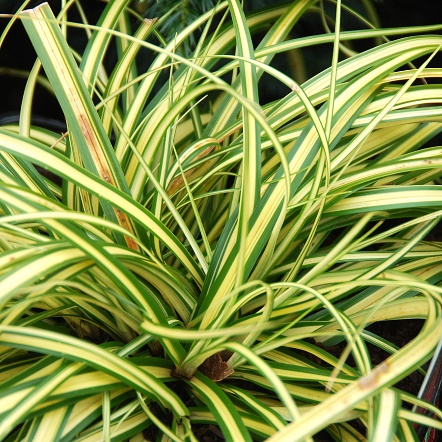 |
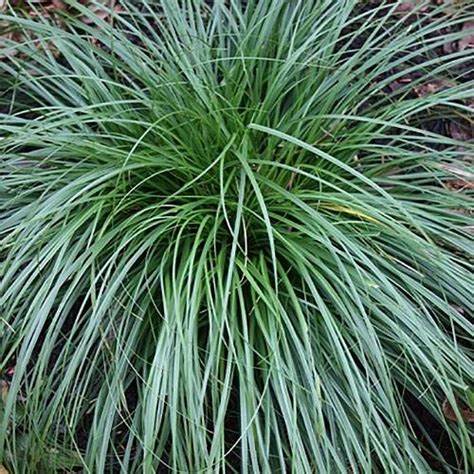 |
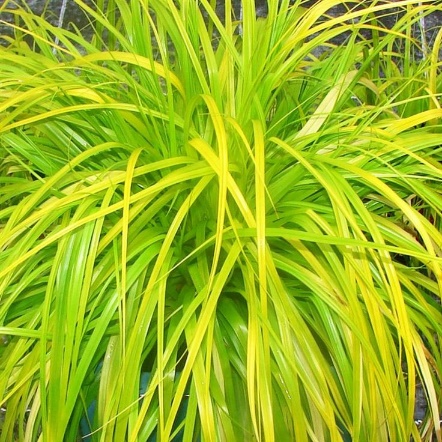 |
Creating a landscape plan can be overwhelming with so many choices of plant types, sizes and colors, incorporating textures and interest, in addition to learning about how to maintain and keep it all healthy and looking good. Consider ornamental grasses as part of your design for a component that will be EASY! Most will require very little attention once established, so you can expend your energy on other areas. Ornamental grasses can provide a distinctive impact that is steadfast year after year with very little care needed. As you’re driving around town, keep an eye out for the striking plumes. Fall is approaching and it’s time for them to show off. You’ll love them, I promise!

